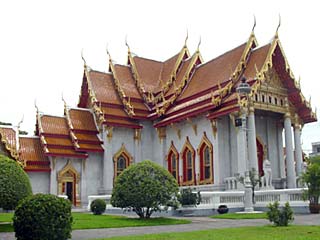An Overview of Buddhist Temples in Thailand
Buddhist temples in Thailand (otherwise known as 'wat') are located in temple compounds and consists of a number of buildings with different architecture, function and importance. Most temples, of course, since having been built in the last century, will be in 'contemporary' or Rattanakosin style, but on the tourist trail and when visiting well reknown wats, you will find different architecture, related to the historical period when the temple compounds were built. Of course, there is a whole science involved in describing the different cultural, religious and architectural aspects of different temples and Buddha images, which goes behind the scope of this summary.
To the layman, the structures inside a temple compound may all look 'similar', but just a little information will allow you to name and localize the different constituent parts.
Important structures include :
Bot (Ubosot) or ordination hall
Sima or boundary stone
Viharn (wiharn, vihan) or sermon hall
Chedi (stupa, pagoda) with relics of the Buddha
Prang (Khmer or Ayutthays style)
Sala or open-sided pavillion
Mondop
Ho Trai or library
Naga
Chofa(h)
Kuti or monk quarters
Bots are sometimes only open to the monks. Inside an altar with several Buddha images.
Ubosoth at Wat Benchamabophit, Bangkok.
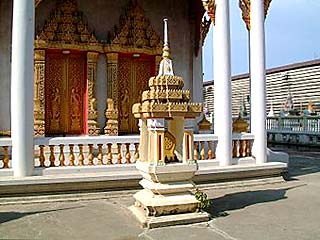
The Viharn or Sermon Hall is often a quite busy building at the wat compounds. Contrary to the ubosoth it does not have sima stones as a boundary. It contains (as the bot) usually a major and many smaller Buddha images, and there are worshippers performing religious rites at most times of the day.
A Sala is a pavillion structure, open on all sites, where people can also take a break during temple visits.
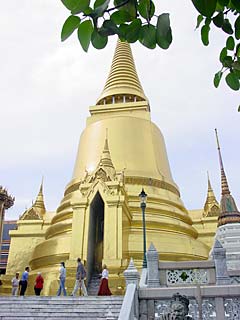
(Chedi at Wat Phrakaew, Bangkok)
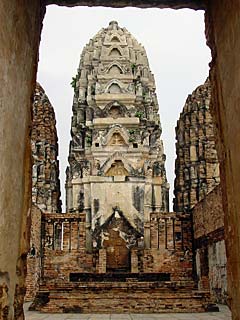
(Prang style building at Sri Sawai, Sukhothai)
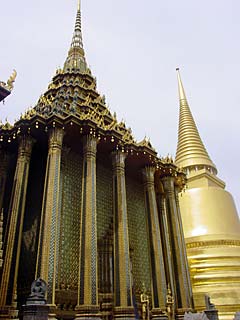
(Mondop at Wat Phrakaew, Bangkok)
The Ho Trai is the library of the wat and usually is small and highly decorated.
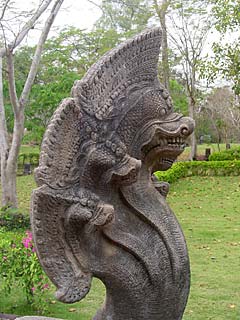
(right : Naga at Phimai, Eastern Thailand)
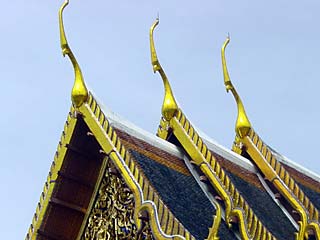
(Chofas at Wat Phrakaew, Bangkok)
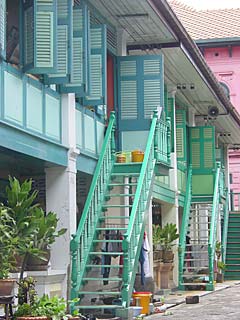
(colorful monk quarters at Wat Benchamabophit, Bangkok)
As with other places of worship, one should always be considerate and respectful. It is often forgotten that temples in Thailand are not just cute and offering a good photo opportunity. Most are still in 'use'. Just consider if you where participating in a religious service at home, and some bunch of tourists would enter your church, starting to take pictures of all statues and even your good self!
While using common sense goes a long way, there are maybe some particular sensitivities you need to know about when visiting Thai temples :
Dress properly. Clothing should cover shoulders and knees. Short skirts are not permitted. Some well visited sites have 'covering clothing' for hire for those who want to enter the temple compound.
You must remove your shoes before entering the temples. One can walk around wearing shoes in the compount itself though. In general people just leave their footwear at the entrance or stairs, but if you just happen to have purchased the latest expensive pair of Nike sportswear, maybe you should take it with you inside.
When sitting down in the wat, do not point you feet towards the altars or Buddha images. As a note, you should understand that feet are considered the 'lowest' part of the body, and you should also avoid pointing them to other people.
Women should never touch monks! Do not hand out something to monks directly. Just use an intermediary, or place an item on a table.
Do not go around touching or having fun in front of Buddha images.
Be considerate when taking pictures. Using telelenses might be acceptable when photographing worshippers.
![]() Characteristics and Postures of the Buddha
Characteristics and Postures of the Buddha
![]() Sitting Buddhas
Sitting Buddhas
![]() Reclining Buddhas
Reclining Buddhas
![]() Seven Days of the Buddha
Seven Days of the Buddha
Hand Gestures :
![]() The Six Main Mudras
The Six Main Mudras
![]() Dhyana Mudra
Dhyana Mudra
![]() Bhumisparsha Mudra
Bhumisparsha Mudra
![]() Abhaya Mudra
Abhaya Mudra
![]() Vitarka Mudra
Vitarka Mudra
![]() Varada Mudra
Varada Mudra
Historical Periods :
![]() Dvaravati
Dvaravati
![]() Khmer-Lopburi
Khmer-Lopburi
![]() Chiang Saen - Lanna
Chiang Saen - Lanna
![]() Sukhothai
Sukhothai
![]() U Thong
U Thong
![]() Ayutthaya
Ayutthaya
Historical Notes :
![]() Dvaravati
Dvaravati
![]() Sukhothai
Sukhothai
![]() Ayutthaya
Ayutthaya
![]() Resources
Resources
Temples in Thailand :
![]() Overview
Overview
![]() Wat Pho
Wat Pho
![]() Wat Benchamabophit
Wat Benchamabophit
Buddha Images at :
![]() Buddha Images at Wat Phra Pathom Chedi
Buddha Images at Wat Phra Pathom Chedi
![]() Introduction to Buddhism in Thailand
Introduction to Buddhism in Thailand
![]() The 10 Jatakas (lives of the Buddha) as depicted in Thai mural Temple paintings
The 10 Jatakas (lives of the Buddha) as depicted in Thai mural Temple paintings
More about Thailand at ThaiWebsites.com : Articles, and Web Directory
Content by Guido Vanhaleweyk, Bangkok.

.png)
